[Editor’s Note: Mad Scientist welcomes back returning guest bloggers MAJ James P. Micciche and CW3 Nick Rife with their insightful post addressing how Joint Force exercises almost exclusively focus on Large Scale Combat Operations (LSCO) — neglecting critical elements of the competition and crisis space leading up to conflict and imbuing our Leaders with “a cognitive handicap limiting critical thought about a given problem.” Agent based simulations using Artificial Intelligence (AI) to provide immersive, cascading effects — ‘emergent behaviors’ — could remedy this critical training gap, enabling Commanders to test their mettle against serial dilemmas, fail safely, and ultimately build the requisite expertise and confidence to successful confront our adversaries, engage them, and win across the full spectrum of operations. “The outcome is users building proficiency to make the best move in competition and crisis while honing analytical tradecraft for conflict with AI as a partner” — Read on!]
In medias res, Latin for “into the middle of things,” is a narrative device in which the audience is immediately thrust into high points of action, intrigue, or conflict with little context of how the characters, setting, or plot arrived there. While this method continues to produce timeless classics of literature, stage, and cinema, its proliferation in Joint Force exercises and wargames is detrimental to the readiness of the Force and prevents clarity of the 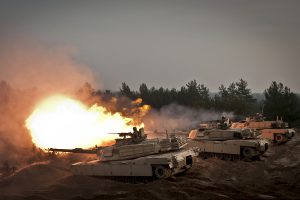 constraints and limitations inherent to the modern operating environment. Hand waiving competition, crisis, generating combat power, theater opening, and post-conflict activities to exclusively focus exercises on the execution of Large Scale Combat Operations (LSCO) normalizes a dangerous assumption that all elements, conditions, and outcomes preceding and succeeding LSCO will favor the United States. Perpetuating this assumption prevents military leadership from understanding the importance of shaping environments and conducting effective analysis in contested or
constraints and limitations inherent to the modern operating environment. Hand waiving competition, crisis, generating combat power, theater opening, and post-conflict activities to exclusively focus exercises on the execution of Large Scale Combat Operations (LSCO) normalizes a dangerous assumption that all elements, conditions, and outcomes preceding and succeeding LSCO will favor the United States. Perpetuating this assumption prevents military leadership from understanding the importance of shaping environments and conducting effective analysis in contested or 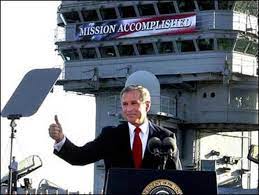 denied theaters. Furthermore, the customary declaration of “mission accomplished” upon defeat of enemy combat forces prolongs a dangerous ongoing trend of bifurcating warfare from war in which the United States excels at the former but remains challenged at the latter. The Joint Force must reassess how, and more importantly when, it begins Joint Event Life Cycle (JELC) scenarios. This assessment must identify and address doctrine, organization, training, materiel, leadership and education, personnel, facilities, and policy (DOTMLPF-P) gaps existing outside of conflict. Moreover, expanding the exercise life cycle aperture enables participants’ opportunities to optimize technological solutions and partner force integration. As a result, opportunities for de-escalation and deterrence in crisis become visible, but the Joint Force retains a marked advantage should conflict conditions arise.
denied theaters. Furthermore, the customary declaration of “mission accomplished” upon defeat of enemy combat forces prolongs a dangerous ongoing trend of bifurcating warfare from war in which the United States excels at the former but remains challenged at the latter. The Joint Force must reassess how, and more importantly when, it begins Joint Event Life Cycle (JELC) scenarios. This assessment must identify and address doctrine, organization, training, materiel, leadership and education, personnel, facilities, and policy (DOTMLPF-P) gaps existing outside of conflict. Moreover, expanding the exercise life cycle aperture enables participants’ opportunities to optimize technological solutions and partner force integration. As a result, opportunities for de-escalation and deterrence in crisis become visible, but the Joint Force retains a marked advantage should conflict conditions arise.

Building Combat Power
Service members taking part in war games or exercises over the past 20 years are familiar with the following saga: A subnational geopolitical crisis occurs in a country located between the United States’ and a revisionist power or rogue state’s sphere of influence. The revisionist power or rogue state capitalizes on said crisis, then invades and degrades the combat forces of the focus country. At this point, Joint Force elements appear in a theater thousands of miles away from their home stations and battlefield geometry is established. U.S. forces are tasked to conduct LSCO and seize a series of objectives which leads to a decisive outcome reestablishing the status quo. In this too familiar playbook, large parts of reality are missing. Like a drunk attempting to recall a previous night’s folly, exercise participants who find themselves in the Combined Joint 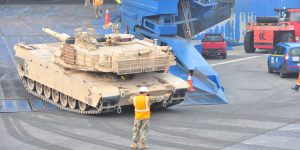 Operational Area (CJOA) are left with a set of curious questions: Where and how did U.S. Forces arrive in the CJOA? How do they travel from port to fort? What conditions exist at every stage of force flow allowing such a transition into an environment at scale? All told, there are months missing in the scenario, crucial months which exist on the precipice of success or failure.
Operational Area (CJOA) are left with a set of curious questions: Where and how did U.S. Forces arrive in the CJOA? How do they travel from port to fort? What conditions exist at every stage of force flow allowing such a transition into an environment at scale? All told, there are months missing in the scenario, crucial months which exist on the precipice of success or failure.
These gaps present a cognitive handicap limiting critical thought about a given problem. They are necessary within the context of Division or Corps training audiences addressing training objectives in the exercise landscape, but present friction points in operational calculus as a result of the in medias res phenomenon. What if a previously neutral populace reacts negatively to 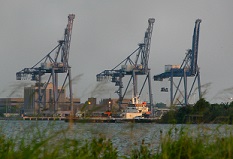 targeted information operations? What if lifeline infrastructure fails at a seaport of debarkation (SPOD) that is overburdened by personnel and materiel? What if the host nation power grid around key terrain infrastructure lacks necessary resilience? There are ostensibly a limitless amount of ‘what if’ questions surrounding every point of force introduction, but finite amount of resources with which to answer those questions accurately. While many will decry the aforementioned variables are not within the purview of the Joint Force, their very existence affects the environment the Joint Force must operate within, and will limit what is expected of U.S. forces in combat.
targeted information operations? What if lifeline infrastructure fails at a seaport of debarkation (SPOD) that is overburdened by personnel and materiel? What if the host nation power grid around key terrain infrastructure lacks necessary resilience? There are ostensibly a limitless amount of ‘what if’ questions surrounding every point of force introduction, but finite amount of resources with which to answer those questions accurately. While many will decry the aforementioned variables are not within the purview of the Joint Force, their very existence affects the environment the Joint Force must operate within, and will limit what is expected of U.S. forces in combat.
With a Little Help from Our Friends?
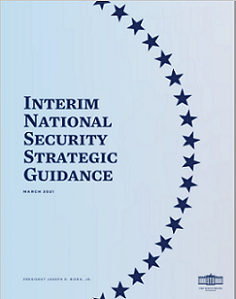 The hyper focus on U.S.-led LSCO ignores a major tenet of the current Interim National Strategic Security Guidance which revolves around strengthening and building partners and alliances. The guidance explicitly outlines that “when force is required, we will employ it alongside international and local partners wherever possible to bolster effectiveness and legitimacy.” As competition evolves to a crisis point which escalates to conflict, adversarial Anti-Access Area Denial (A2AD) platforms, coercive economic practices, and law-fare will severely restrict the Joint Force from projecting and employing combat power to the point of need. Strategic competitors develop and implement A2AD technology to counter the basis of U.S. military power, expeditionary deployment, and maneuver
The hyper focus on U.S.-led LSCO ignores a major tenet of the current Interim National Strategic Security Guidance which revolves around strengthening and building partners and alliances. The guidance explicitly outlines that “when force is required, we will employ it alongside international and local partners wherever possible to bolster effectiveness and legitimacy.” As competition evolves to a crisis point which escalates to conflict, adversarial Anti-Access Area Denial (A2AD) platforms, coercive economic practices, and law-fare will severely restrict the Joint Force from projecting and employing combat power to the point of need. Strategic competitors develop and implement A2AD technology to counter the basis of U.S. military power, expeditionary deployment, and maneuver 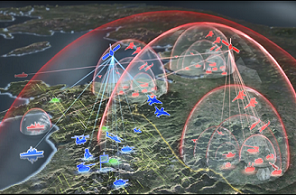 centric warfare. This results in a paradigm shift where the defense is the stronger form of warfare, something that is counter-intuitive to the U.S. way of war. As the Joint Force attempts to penetrate A2AD frameworks to project force forward, U.S. allies and partners are already inside. Skipping almost all activities before US-led LSCO, Joint Force commanders lose valuable repetitions on how to integrate U.S. capabilities in support of partner and allied forces already in conflict.
centric warfare. This results in a paradigm shift where the defense is the stronger form of warfare, something that is counter-intuitive to the U.S. way of war. As the Joint Force attempts to penetrate A2AD frameworks to project force forward, U.S. allies and partners are already inside. Skipping almost all activities before US-led LSCO, Joint Force commanders lose valuable repetitions on how to integrate U.S. capabilities in support of partner and allied forces already in conflict. 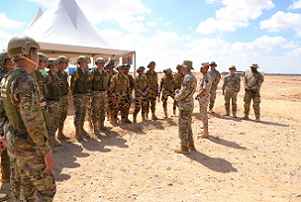 These repetitions enable more rapid penetration into the contact layer. The United States Army has purpose built forces such as Security Force Assistance Brigades (SFABs) and Special Forces Operational Detachment Alphas (ODAs) who not only enhance partners and allies, but enable the delivery of long-range multi-domain effects to shape the CJOA or facilitate return to competition. Ignoring those forces and the effects they generate degrades any comprehensive learning experience exercise participants have.
These repetitions enable more rapid penetration into the contact layer. The United States Army has purpose built forces such as Security Force Assistance Brigades (SFABs) and Special Forces Operational Detachment Alphas (ODAs) who not only enhance partners and allies, but enable the delivery of long-range multi-domain effects to shape the CJOA or facilitate return to competition. Ignoring those forces and the effects they generate degrades any comprehensive learning experience exercise participants have.
Industrial Base – The Black Swan
 Success in war is often predicated on economic power and production of war materiel. Simply put, Soldiers need bullets, bombers need bombs, and everything else needs fuel. The amount of materiel produced in historic large scale conflicts is staggering. In the First World War, the British Empire alone fired around 170 million artillery shells over four years and at peak production, produced 50 million shells a year. During the Second World War, American factories were producing a finished B-24 Liberator, a long-range bomber with over 1.5 million parts, every 63 minutes. The militaries of the twenty-first century are far more technologically advanced and smaller in size than their twentieth century forebears, but that does not change the intensity of LSCO. It
Success in war is often predicated on economic power and production of war materiel. Simply put, Soldiers need bullets, bombers need bombs, and everything else needs fuel. The amount of materiel produced in historic large scale conflicts is staggering. In the First World War, the British Empire alone fired around 170 million artillery shells over four years and at peak production, produced 50 million shells a year. During the Second World War, American factories were producing a finished B-24 Liberator, a long-range bomber with over 1.5 million parts, every 63 minutes. The militaries of the twenty-first century are far more technologically advanced and smaller in size than their twentieth century forebears, but that does not change the intensity of LSCO. It 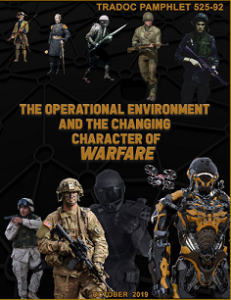 makes battlefield losses far more impactful. This concept is highlighted in the Army’s Training and Doctrine Command (TRADOC) pamphlet titled The Operational Environment and the Changing Character of Warfare, “Force-on-force conflict will be so destructive, will be waged at the new speed of human and AI enhanced interaction, and will occur at such extended long-ranges that exquisitely trained and equipped forces facing a strategic competitor will rapidly suffer significant losses in manpower and equipment that will be difficult to replace.” A contemporary example of the destruction of modern LSCO was the Second Nagorno-Karabakh War (Sep – Nov 2020) in which Armenia and Azerbaijan lost 249 and 56 tanks, respectively, in a six-week long war.
makes battlefield losses far more impactful. This concept is highlighted in the Army’s Training and Doctrine Command (TRADOC) pamphlet titled The Operational Environment and the Changing Character of Warfare, “Force-on-force conflict will be so destructive, will be waged at the new speed of human and AI enhanced interaction, and will occur at such extended long-ranges that exquisitely trained and equipped forces facing a strategic competitor will rapidly suffer significant losses in manpower and equipment that will be difficult to replace.” A contemporary example of the destruction of modern LSCO was the Second Nagorno-Karabakh War (Sep – Nov 2020) in which Armenia and Azerbaijan lost 249 and 56 tanks, respectively, in a six-week long war.
Exercises and wargames focusing only on the application of combat power in LSCO establish a flawed understanding of warfare. In essence, the force develops, practices, and reinforces ways unconstrained by the reality of means. Commanders will face a series of resource related dilemmas during LSCO including the attrition of their forces before ever reaching the CJOA through significant shortfalls of needed materiel and supplies. 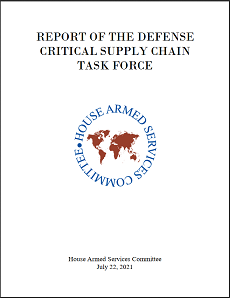 During crisis and conflict, the globally integrated and interdependent supply chains will allow strategic competitors to deny the U.S. resources required to produce the material needed to effectively wage war. The House Armed Services Committee articulated the threat vis-à-vis China in a bipartisan report on the vulnerabilities of the defense critical supply chain, “a significant amount of material in the Defense Industrial Base is sole-sourced from the People’s Republic of China.” Furthermore, an annual report by the National Defense Industrial Association paints a bleak picture. The findings indicate the U.S. defense industrial base and associated infrastructure is not only vulnerable to cyber-attacks, but its
During crisis and conflict, the globally integrated and interdependent supply chains will allow strategic competitors to deny the U.S. resources required to produce the material needed to effectively wage war. The House Armed Services Committee articulated the threat vis-à-vis China in a bipartisan report on the vulnerabilities of the defense critical supply chain, “a significant amount of material in the Defense Industrial Base is sole-sourced from the People’s Republic of China.” Furthermore, an annual report by the National Defense Industrial Association paints a bleak picture. The findings indicate the U.S. defense industrial base and associated infrastructure is not only vulnerable to cyber-attacks, but its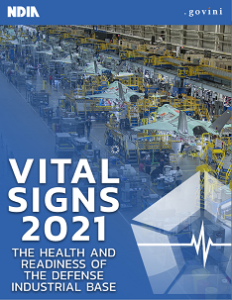 “productive capacity and surge readiness form a current weak spot.” Based on the factors above, realistic training simulations must include usage caps on ammunition, fuel, and materiel to force Commanders to adapt to the true reality of 21st century LSCO, forcing them into a series of dilemmas that alternate between bad and worse decisions – failing as a forcing function.
“productive capacity and surge readiness form a current weak spot.” Based on the factors above, realistic training simulations must include usage caps on ammunition, fuel, and materiel to force Commanders to adapt to the true reality of 21st century LSCO, forcing them into a series of dilemmas that alternate between bad and worse decisions – failing as a forcing function.
Simulating Competition / Deterrence
The anatomy of modern competition and deterrence solutions exist on a global scale. Operational variability permeating at this scale is infinite; and so too are the list of decisions that lead to distinct outcomes. How do commanders, staffs, and analysts answer questions within this continuum with scale and clarity? What conditions manifest as a result of cascading multi-system and multi-domain effects in the operating environment? Currently, the Joint Force relies primarily on senior leader experience, academic or domain specific study, or good old fashion staff analysis. Considering the evolving character of war mentioned above, each of these methods is unsound. Leveraging AI-driven simulations for competition and deterrence provides a digital twin of a real environment on a much more vast scale. This immersive digital environment allows users to experiment with various strategies and recognize decisional effects over time. 
Agent based simulations, comprised of agents and domains, provide the most immersive backdrop capable of connecting analysts and decision makers to the effects of their analysis and decisions. Cascading effects, known as ‘emergent behaviors,’ are those behaviors in an environment that emerge as a result of interaction between ‘agents’ in a given space. What if a Commander encourages his host nation partner to limit rail travel in a metropolitan area as a crisis point erupts? Leveraging agent based simulation, users might test that  action in a digital space to assess how the populace might respond. What if the host nation prohibits travel during hours of darkness? What if the host nation turns off power in a 10 kilometer radius of any identified key terrain spaces? What if the Joint air component targets critical adversary infrastructure, but it is located in a densely populated area? Answers to these questions and the demonstrated effects they have on the agents within that space are all observable at scale and with precision in agent based simulation.
action in a digital space to assess how the populace might respond. What if the host nation prohibits travel during hours of darkness? What if the host nation turns off power in a 10 kilometer radius of any identified key terrain spaces? What if the Joint air component targets critical adversary infrastructure, but it is located in a densely populated area? Answers to these questions and the demonstrated effects they have on the agents within that space are all observable at scale and with precision in agent based simulation.
Evolving simulations to this point is often thought of as unattainable science fiction, yet atomic bombs, jet fighters, and synthetic rubber existed only in novels in 1941. By 1945, however, all had been created and employed within the context of large scale combat. The myriad of factors and interactions between instruments of national power that make LSCO between strategic competitors less likely are the norm. Provided this simple fact, the United States is at a marked disadvantage in developing forces, tactics, and operational concepts that support action below the threshold of major armed conflict. As great power competitors project influence within such a paradigm, they do so in far flung domains and spaces. Agent based simulations may play a critical role in accessing those spaces without physically being there.
Conclusion
As the world’s complexity swells and peer adversaries become increasingly sophisticated in how they compete with and contest US influence, a sea change in how the Joint Force develops competencies preceding and succeeding LSCO must be undertaken. The Joint Force can leverage agent based simulation to understand complex, real-world scenarios and test ways to improve them as a fast, risk-free way to answer “what if” questions compared to action. The outcome is users building proficiency to make the best move in competition and crisis while honing analytical tradecraft for conflict with AI as a partner. This transformation mitigates the effects of “In Medias Res” and accounts for the “ad infinitum” nature of great power competition.
If you liked this post, check out MAJ James P. Micciche and CW3 Nick Rife‘s previous post Weighing Effort in the Future Strategic Environment 2028-2035
… learn how warfighting is so much more than LSCO in:
Blurring Lines Between Competition and Conflict
Sub-threshold Maneuver and the Flanking of U.S. National Security, by Dr. Russell Glenn
“Once More unto The Breach Dear Friends”: From English Longbows to Azerbaijani Drones, Army Modernization STILL Means More than Materiel, by Ian Sullivan
In It to Win It: Competition, Crisis, & Conflict
Global Entanglement and Multi-Reality Warfare with COL Stefan Banach (USA-Ret.) and associated podcast
The Convergence: Hybrid Threats and Liminal Warfare with Dr. David Kilcullen, associated podcast, and the video [access via a non-DoD network] and notes from Mad Scientist’s Operational Environment and Conflict over the Next Decade webinar on 19 January 2021, featuring Dr. T.X. Hammes. Dr. David Kilcullen, and Dr. Sean McFate
The Convergence: The Future of Ground Warfare with COL Scott Shaw and associated podcast
The Future of War is Cyber! by CPT Casey Igo and CPT Christian Turley
… and read about how simulation and gaming can prepare our Leaders for operations spanning competition, crisis, and conflict in:
“No Option is Excluded” — Using Wargaming to Envision a Chinese Assault on Taiwan and Would You Like to Play a Game? Wargaming as a Learning Experience and Key Assumptions Check, by Ian Sullivan
A New American Way of Training with Jennifer McArdle and associated podcast
From Legos to Modular Simulation Architectures: Enabling the Power of Future (War) Play, by Jennifer McArdle and Caitlin Dohrman
The Metaverse: Blurring Reality and Digital Lives with Cathy Hackl and associated podcast
Gamers Building the Future Force and associated podcast
Fight Club Prepares Lt Col Maddie Novák for Cross-Dimension Manoeuvre, by LTC(P) Arnel David, U.S. Army, and Major Aaron Moore, British Army, along with their interview in The Convergence: UK Fight Club – Gaming the Future Army and associated podcast
Major James P. Micciche is a U.S. Army Strategist and Civil Affairs Officer with deployment and service experience in the Middle East, Africa, Afghanistan, Europe, and Indo-Pacific. He is currently the G5 at the Security Forces Assistance Command. He holds degrees from the Fletcher School at Tufts University and Troy University.
Chief Warrant Officer 3 Nick Rife, U.S. Army, is the senior intelligence technician for 2nd Security Force Assistance Brigade, Fort Bragg, North Carolina, and serves as contributing member to the Army Intelligence Corps Digital Initiatives Group. He previously served at U.S. Army Forces Command G-2 as the principal developer of the Digital Intelligence Systems Master Gunner Course, fusion chief at 82nd Airborne Division G-2, and 4th Brigade Combat Team, 82nd Airborne Division.
Disclaimer: The views expressed in this blog post do not necessarily reflect those of the Department of Defense, Department of the Army, Army Futures Command (AFC), or U.S. Army Training and Doctrine Command (TRADOC).



